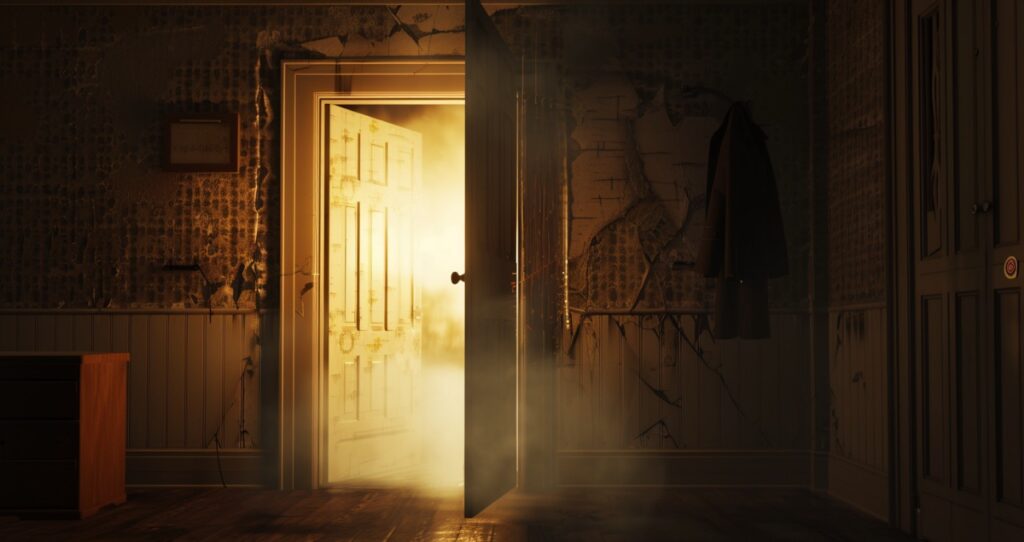
Blueprints for Escaping the Collapse: Exit Strategies for the End of the Simulation
This is crack four — the one where the simulation forgets to lie.
By now, the seams are no longer shy. You’ve seen the corridor stretch. You’ve felt the floor flicker under your heel. You’ve dragged your city through three layers of glitch and grief, stitched your walls to old memories like a stubborn architect clinging to the last working blueprint. But now the hum isn’t in the drywall — it’s in you.
And it’s getting louder.
The simulation is leaking. It’s not collapsing like a Hollywood fireball — it’s unraveling like a bad dream remembered sideways. And some of us? We’ve started drawing exits. Not out of panic, but instinct. The same way ants find the edge of the table. The same way water finds the crack in the dam.
We’re not escaping. We’re rehearsing.
Think about it. Why do we keep building digital twins? Mirror cities humming in sync, whispering your air quality, your shadow length, your blood-pressure tap. Why the obsession with headsets, with metaverses, with neon lobbies we’ll never walk through in flesh? Because some part of us suspects the next layer already exists — and we’d rather practice living there before this one winks out.
Architects won’t say it out loud, but we design for collapse. Every emergency stairwell, every ventilation shaft, every suspiciously oversized lobby — they’re not just for flow. They’re fallback plans. Escape architecture dressed up in glass and concrete. You call it “circulation. ” I call it running drills.

The signs are everywhere. You pass them daily. The door that’s never unlocked. The hallway that leads nowhere but still gets cleaned. The blank wall you swear had a window last week. Not mistakes. Not bad design. Just the old simulation wheezing and the new one pressing through.
And then come the dreams. You know the ones.
You wake up remembering a room you’ve never seen but can describe in perfect detail. You dream of buildings that don’t exist — or worse, buildings that used to. A station platform with no city. A stairwell that ends midair. A rooftop garden that watches you back. Half-real, half-coded. A memory caught between renders.
Some of us call this psychosis. Others call it prepping.
Because let’s say — just for fun — that this reality is not only simulated, but nested. One layer inside another. A simulation within a simulation, like Matryoshka dolls made of light. What happens when the one you’re standing in starts to buckle? Simple: you jump to the next. You bring what you can. You drag your walls. You sharpen your exits.
This isn’t apocalypse. This is inheritance.
And like all inheritance, it comes with ghosts. Every time the layer shifts, the bleed gets stronger. Glitches no longer reset — they linger. You see the same dog on three streets. You watch a plane freeze mid-sky. You swear your building’s lobby used to be blue.
It did.
But not in this version.
Don’t panic. That’s just the next layer humming through.
It’s not subtle anymore. The floorplan flickers. The shadows stutter. Your own reflection starts showing up one blink behind.
The simulation is failing its own consistency check.
And we — well, we’re mapping the exits like polite traitors. Some of us have started keeping keys to doors that don’t exist yet. Others walk hallways backwards to see if the geometry loops. Some of us sketch dream architecture in journals with margins wide enough for the next world to crawl in.
So next time the elevator stalls between floors, don’t press the button. Don’t call for help. Just listen. That silence? It’s not mechanical. It’s a breath being held.

When the layer peels, it won’t announce itself. No sirens, no rupture. Just a slow warping of the familiar — your kitchen tilting five degrees off trust, a faucet dripping water that doesn’t quite reflect, a window showing a sky no one remembers coding.
It’s not a glitch. It’s the seam stretching — just enough for something else to start leaking in.
And if you flinch, it resets. The simulation hates being caught.
So hold still. Let it flicker. Let the wrong geometry settle around you like dust. Don’t try to fix it —this version isn’t yours to edit anymore.
What comes next won’t ask for permission. It’s already been installed.
Your only job now is to survive the transition without blinking.
Crack Five will open the door the glitch is hiding behind.
Make sure you’re ready to follow it through.



